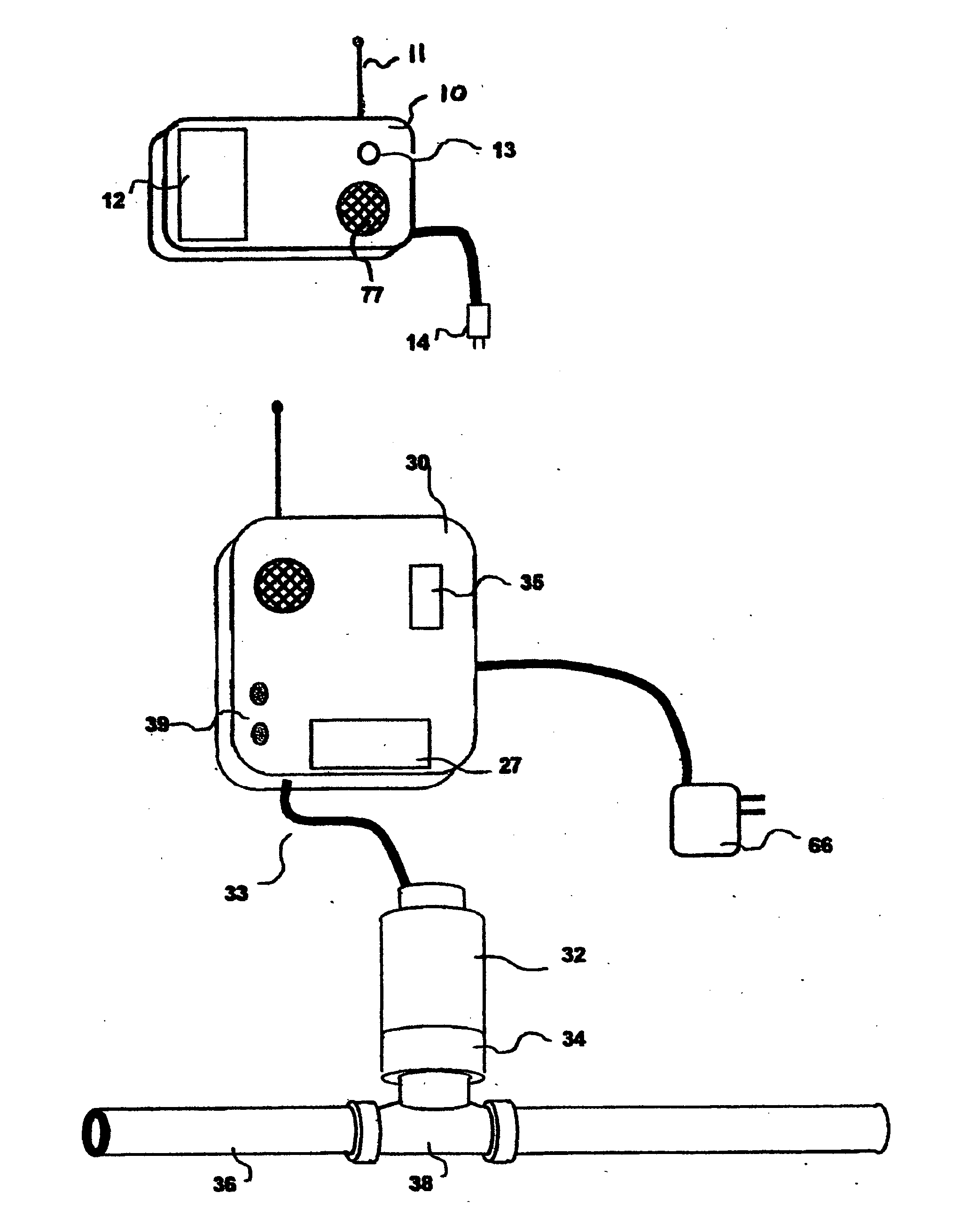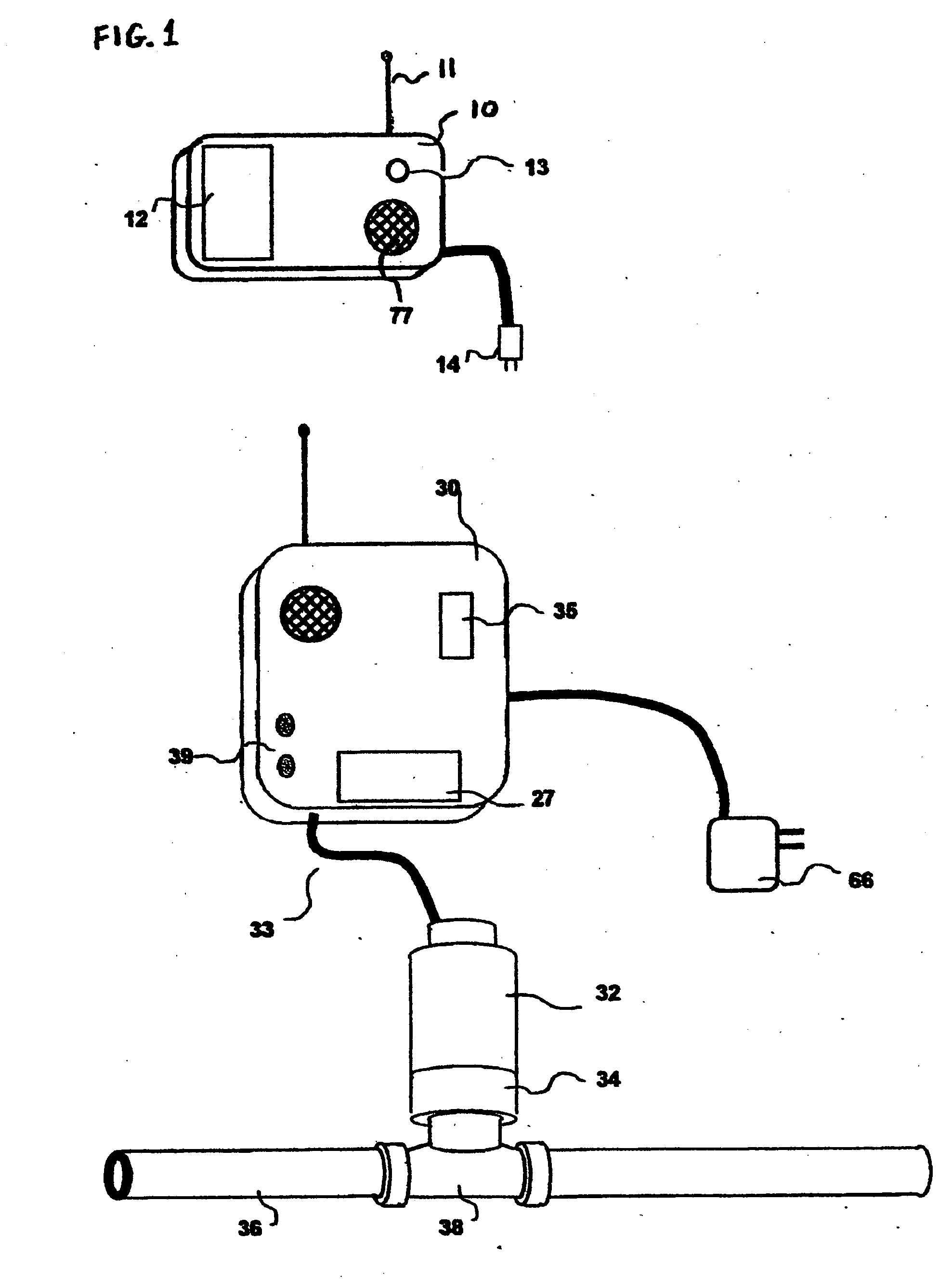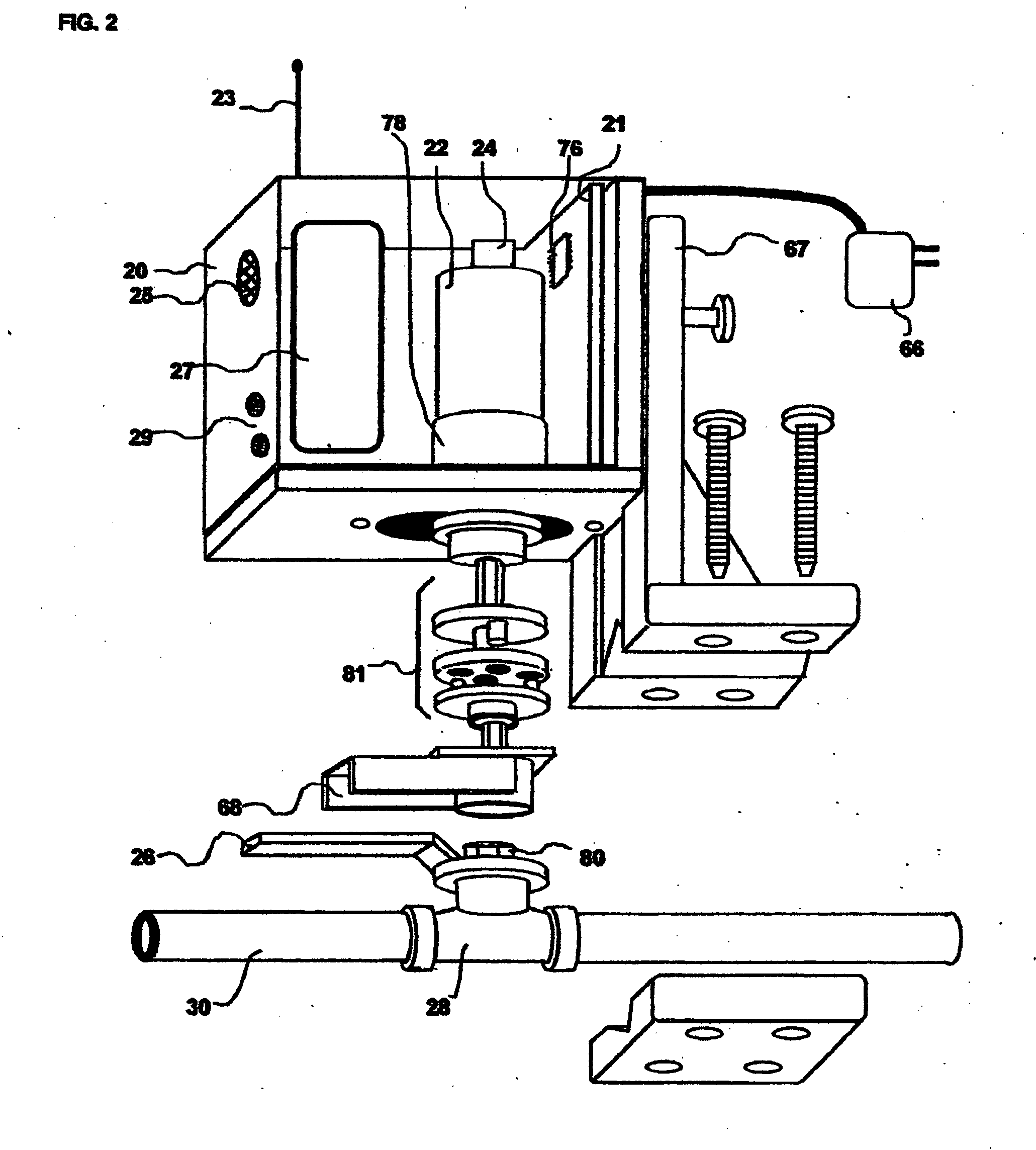The teachings found in prior arts are not able to provide adequate methods to secure the positive operation leak detection and prevention, in particularly teachings found in prior arts fail to provide fully supervised leak detection and
damage control system, which ascertains system operation in accordance with the embodiment of the invention.
One can presume if Jacobson et al. system was used on a rusted or frozen valve, the motor would not been able to turn the valve to its fully closed position.
The valve will thus remain open, which then fails to stop the leak and prevent property damage, or cause bodily injury or even
human life loss, in such event where there is a
gas leak.
Also, if a phone
dialer was used it would have provided misleading information to the monitoring
station.
The use of
pressure sensing method may not be reliable to detect a variety of slow leak conditions.
Some leaks could be large enough to be easily detected, other leaks could be too small to create a detectable pressure drop, therefore when such system is in use, if and when a
gas leak occurs during a period of time it builds up enough gas in a facility, which could create an undetected dangerous condition.
Another
disadvantage of the prior art is that, it cannot determine if a drop in
gas pressure is created by a leak or by normal use of appliances.
In addition, the prior art teaching does not utilize a supervisory valve shut off mechanism, valve motor failure to close the valve successfully, and accordingly initiate local alarm indication and signal an auto-
dialer unit, to report the unsuccessful valve shut-off condition to a monitoring
station.
Even though the prior art is useful, but it does not utilize electronic circuitry to detect motor or gear turn
cycle count to ascertain successful valve closure, and report successful or un-successful valve shut off condition through local audiovisual indication or through auto-dialer.
Therefore the prior art is not as a reliable for use.
Such method cannot be useful in applications where a plurality of location water leaks may be detected by the use of sensors and activate remotely located valve
control unit to close the valve when a leak condition occurs.
Even though the prior art is useful, using rotating
water pipe flow sensor, has it's limitations due to the fact that the system cannot know when some one is going to apply little or large amount of
water use at any given time of the day, thus the day,
timer set up in the art teaching is useful only in certain application, the use of teaching has the potential for false alarms.
In addition the method does not provide a shut-off valve motor or gear counter to supervised successful closure of valve, and the auto-dialer found in the prior art, reports only when
excess water flows through the
pipe, without giving any confirmation of shut-off valve closure status.
Useful prior art, but the teaching does not utilize any means of detecting un-successful valve closure, and accordingly generate audiovisual alarm signals when unsuccessful valve closure condition occurs.
In addition, the base unit does not provide any means to notify through auto dialer the successful or unsuccessful valve closure condition to monitoring personnel.
The use of such basic shut-off valve does not provide secure
water leak damage prevention.
The prior art is useful, but it does not provide lasting and secure method of shutting a valve mechanism, as spring (or
gas pressure) mechanism is not
long lasting reliable alternative to control a shut-off valve.
D'Antonio, et al method of regulating a spring motor malfunction warning signals in response to the breakage of spring is an improvement, but such method is not reliable in long term use.
Also the prior art teaching does not provide a means of reporting the successful or un-successful valve shut-off information through local alarm, phone auto dialer or by
wireless means.
Even though Purvis, et al. teaching found to be useful, it does not provide a lasting and secure method of shutting a valve mechanism, as
cam switches are made of mechanical contacts having a spring mechanism, which does not provide
long lasting reliable means to control a shut-off valve.
As known, dust,
moisture, residue and switch spring mechanism has the potential to breakdown in long term usage.
Additionally Purvis, et al. teaching does not provide means of reporting the successful or un-successful motor valve shut-off condition information through a local audiovisual signals, or use of a phone auto dialer or by wireless means to report said conditions to a monitoring
station.
The use of
camshaft switch for determining motor close or open position, limits the use of the art to be installed only within a pipes.
Even though prior art teaching of adapting a motorize valve to close an existing manual valve is useful, mounting the motor on a manual valve with the use of a J shape support bracket and rigidly attaching the
valve stem to
motor shaft by use of a connector, has reliability limitations.
In addition the use of J shape support bracket may not provide the needed support to securely
mount the valve control motor housing on the
pipe this could create
motor shaft binding due to misalignment.
In addition Dwyers, Jr. teaching does not provide any means of detecting successful valve closure or valve open condition.
Therefore use of unsupervised motor rotation may not put the valve in a complete close position, one can rely on Dwers, Jr. teaching, and only afterwards find out that damage has already been done to property due to
system failure.
The prior art method can only be used on a manual valve; it has no provision for use with other installed electrically actuated valves.
The teachings found in Sanders are perhaps found to be useful, and it is an improvement to art, but use of low power RF
wall mount or
hand held transmitter has it's limitation, due to it is used to turn On / Off a motor valve from a
short distance within a facility.
Sanders teaching rather provides a processor
timer circuitry to determine valve closure, which is know to be not accurate in long term use due to valve variation, environmental and temperature conditions, and motor / gear mechanism tolerance.
The teaching may not be applicable to use with different valves styles, due to valve closure or open turn cycle that vary from one valve to another.
The teaching found in Sanders does not provide supervisory shot-off valve closure or valve open condition reporting through an auto-dialer, nor is it able to conduct periodic supervisory motor valve closure test and reporting, or use learning mode set up method for system memorize the number of motor or
actuator shaft turn cycle required for complete close / open operation on any type of valve it is applied to.
Further Sanders art does not teach the use of an auto-dialer that includes a PSTN / Cellular, or
satellite receiver means capable of receiving command from distant locations to open or close the valve, and correspondingly receive confirmation that the valve has been successfully closed.
In addition Sanders teaching, does not provide an RF computer interface
transceiver unit which is capable of receiving the transmitted leak detection signals from leak sensors, and display the sensor unit ID on a computer screen within
a site.
Jacobsen et al. have no provisions to circumvent this potential problem and this is particularly critical in their mode of operation where they rely only on a stalled motor for control.
Further since Sanders did not teach a closure detection sensor switch he was no help in the matter.
 Login to View More
Login to View More  Login to View More
Login to View More 


